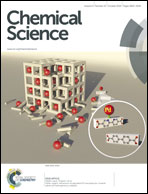Wavelength dependent efficient photoreduction of redox mediators using type II ZnSe/CdS nanorod heterostructures†
Abstract
One-dimensional quantum confined nanorod heterostructures (such as CdSe/CdS and ZnSe/CdS dot-in-rod) have been intensively investigated as light harvesting and charge separation materials for solar energy conversation because of the possibilities of rational incorporation of catalysts and achieving long distance charge separation though the selection of component materials with desired band alignment and dimension (diameter and length). To establish design principles for these materials, we have examined the redox mediator (methyl viologen, MV2+) photoreduction process using ZnSe/CdS type II dot-in-rod nanorods. We show that the steady state MV2+ photoreduction quantum yields, in the presence of mercaptopropionic acid as electron donor, were 34% at 550 nm and 90% at 415 nm, respectively. Using transient absorption spectroscopy and time-resolved fluorescence decay, we followed the rates of electron and hole localization within the rod, interfacial transfer to acceptors, and charge recombination processes. It was shown that 550 nm excitation generated excitons in the charge transfer state with holes in the ZnSe seed and electrons at the CdS bulb region surrounding the seed. Electron transfer to MV2+ formed a charge separated state with relatively small electron–hole spatial separation, leading to a larger charge recombination loss and a smaller steady-state quantum yield of MV2+ photoreduction. The excitons generated in the CdS rod region by 415 nm excitation underwent three charge separation pathways. The majority pathway led to long-distance charge separation with the electrons in the reduced MV2+ adsorbed on the rod and holes localized in the ZnSe seed, which suppressed recombination and resulted in the observed higher steady state quantum yield. We discuss possible approaches to control the branching ratios of different exciton localization/dissociation pathways and to improve the quantum efficiency of photoreduction.


 Please wait while we load your content...
Please wait while we load your content...